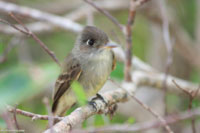Common permanent resident in Cuba, Isle of Youth and some cays. It is an Cuban endemic subspecies represented by two distinct populations restricted to Jardines de la Reina archipelago: C. c. nerlyi and C. c. florentinoi. Cuban Pewee reaches 16 cm long and its distinct features are: a broad and flattened bill with a fleshy-colored lower mandible and a white half-circle behind eyes. It can be found along the insular group: Bretón, Alcatracito, Alcatraz, Grande, Caballones, Anclitas, Boca Piedra Piloto, Cruces, Juan Grin, Caguama and Cabeza del Este.
Tawny-shouldered Blackbird (Agelaius humeralis ssp):
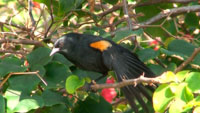
Common permanent resident in Cuba and several larger cays in both coasts. It is considered a cuban endemic subspecies with a potential new population inhabiting Jardines de la Reina cays. Tawny-shouldered Blackbird reaches 20 cm long. Its distinct features are: entirely black plumage with a brownish-orange spot on shoulders and tail forked with rounded tip feathers. Distibution range comprises several cays such as: Grande, Caballones, Anclitas, Boca Piedra Piloto, Boca Piedra Chica, Boca Grande, Cruces, Cachiboca, Boca Seca, Boca Rica, Campo Santo, Juan Grin, Caguama, Cabeza del Este.
Cuba Green Woodpecker (Xiphidiopicus percussus ssp):

Common permanent resident in Cuba, Isle of Youth and some cays in both coasts. It is one of the seven Cuban endemic genera and represented in Jardines de la Reina by potential subspecies. Cuba Green Woodpecker reaches 23 cm. Its distinct features are: green-olive back, light yellow belly with dark brown stripes, red spot on the throat base and upper part of chest. It is the only woodpecker that makes a peculiar sound with wings when approaching the nest as an acoustic sign ritualizing the nest care replacement between parents. It has been recorded in Grande, Caballones, Anclitas, Boca Piedra Chica, Cruces, Boca Seca, Caguama, Cabeza del Este.
Red-Legged Thrush (Turdus plumbeus ssp):
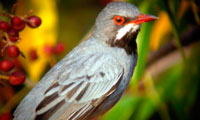
Common permanent resident in Cuba, Isle of Youth and many cays in both coasts. It is thought to be a potential subspecies in Jardines de la Reina. Red-Legged Thrush reaches 27 cm. Its distinct features are: gray, eye ring and leg red-orange, peak orange or black, throat black. Its known distribution range barely includes few central cays of the Laberinto de las Doce Leguas (Grande, Caballones, Anclitas). In addition, its occurrence has not been recorded in the last 15 yrs despite several surveys have been conducted in aforementioned localities, so it´s plausible to think that it would have undergone a local extirpation. Based on external features of one specimen collected from Caballones in 1930 and deposited at the Smithsonian Institution, this population may have represented an intergraded form between the two known populations (T. p. rubripes and T. p. schistaceus) occurring in Cuba.
Peregrine Falcon (Falco peregrinus):
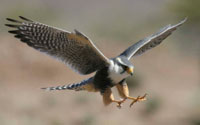
Common winter resident and transient in Cuba, Isle of Youth and some northern cays. It reaches 46 cm long. Its distinct features are: upperparts gray to dark brown, black head, underside whitish brown-barred, and a variable facial vertical black stripe, tail long narrowing to its tip and slightly barred from underneath. Peregrine Falcon is considered as a rare species in Jardines de la Reina, only recorded in Anclitas and Caguama cays. It is included in the Appendix I of Resolution 161/11.
Merlin (Falco columbarius):

Common winter resident and transient in Cuba, Isle of Youth and some larger cays. It reaches 30 cm long. Its distinct features are: Upperparts blue-dark grayish (male), or brown with grayish uppertail coverts (female), cinnamon-colored underparts with brown streaks, poorly defined vertical stripe below eye, tail boldly banded in light gray and black with a white tip. Merlin has only been documented in cayos Grande, Caballones and Anclitas. It is included in the Appendix I of Resolution 161/11.
Common Barn-Owl (Tyto alba):
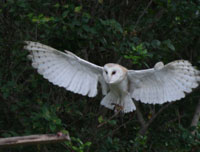
Common permanent resident in Cuba, Isle of Youth and some cays as well as a very rare winter resident. It reaches 38 cm. Its distinct features are: upperparts yellowish-cinnamon brown, underparts white or pale beige with sparse and minute brown spots. Its occurrence in Jardines de la Reina was formerly known from anecdotal references until a single individual was sighted in the coastal mangroves of Boca Piedra Piloto cay in June 2005. Common Barn-Owl is included in the Appendix I of Resolution 161/11. Where??
Cuban Black-Hawk (Buteogallus gundlachii):

Common resident in Cuba, Isle of Youth and cays and it is considered a Cuban endemic species. It reaches 53 cm. Its distinct features are: dark-chocolate brown with broad, rounded wings with a white patch at base of primaries clearly visible in flight, tail short with broad white-black bands, base of bill and legs. Cuban Black-Hawk is observed along Jardines de la Reina (Bretón, Cinco Balas, Alcatraz, Alcatracito, Grande, Caballones, Anclitas, Cruces, Cachiboca, Boca Seca, Caguama and Cabeza del Este). The Cuban common name comes from its sound: ba-tis-ta. It is included in the Appendix I of Resolution 161/11.
Red-Tailed Hawk (Buteo jamaicensis):
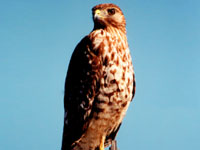
Common and widely distributed permanent resident in Cuba and cayo Coco. It reaches 56 cm. Its distinct features are: upperparts brown, underparts whitish underside with brown spots across the belly, long, broad and rounded winds with distinct dark bar and wrist patch on leading edge, entirely rufous tail (adults) or brown barred (inmatures). Red-Tailed Hawk has been only recorded in Anclitas, Caguama, and is included in the Appendix I of Resolution 161/11.
Osprey (Pandion haliaetus):

Common as winter resident and transient (P. h. carolinensis) in Cuba, Isle of Youth and cays, but permanent resident populations are more rare and represented by a local subspecies (P. h. ridwayi), restricted to surrounding archipelagos and cays. It reaches 58 cm. Its distinct features are: upperparts dark brown, white underparts. In flight, the long wings have a conspicuous black patch on wrist and black tips. Stripe through the eye broad dark in migrant individuals or paler in residents. Ospreys feed on fish. It is included in the Appendix I of Resolution 161/11. It is widely represented along Jardines de la Reina cays, whose distribution range comprises Bretón, Cinco Balas, Alcatracito, Alcatraz, Grande, Caballones, Anclitas, Boca Piedra Piloto, Boca Piedra Chica, Cruces, Cachiboca, Boca Seca, Juan Grin, Caguama and Cabeza del Este.
Double-crested Cormorant (Phalacrocorax auritus):

Common permanent resident and rare winter resident in Cuba, Isle of Youth and some cays. It reaches 81 cm long. Its distinct features are: black overall with a green metallic sheen evident in good light, bare facial skin and rounded orange throat pouch. Double-crested Cormorant is an excellent swimmer-diver which feeds on fish. This coastal-marine bird and colonial-breeder shows a very wide distribution and represented by large populations being reported in most cays of Jardines de la Reina (Bretón, Cinco Balas, Alcatracito, Alcatraz, Grande, Caballones, Anclitas, Boca Piedra Piloto, Boca Piedra Chica, Largo, Boca Grande, Cruces, Cachiboca, Boca Seca, Juan Grin, Caguama, Cabeza del Este). Double-crested Cormorant is included in the Appendix II of Resolution 161/11.
Anhinga (Anhinga anhinga):
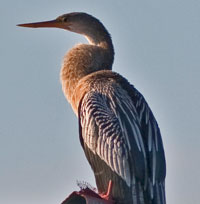
Common permanent resident and rare winter resident in Cuba, Isle of Youth and some cays. It reaches 89 cm. Its distinct features are: blackish-brown with green iridescence (male), head, neck and chest pale brown (female), large silvery white areas on upper wing long neck, yellow bill, tail long with white tip. Anhinga is an excellent swimmer and feed on fish. It inhabits shallow waters along the entire archipelago being reported in many cays (Bretón, Cinco Balas, Alcatraz, Grande, Caballones, Anclitas, Boca Piedra Chica, Cruces, Boca Rica, Juan Grin, Caguama, Cabeza del Este) Anhinga is included in the Appendix II of Resolution 161/11.



